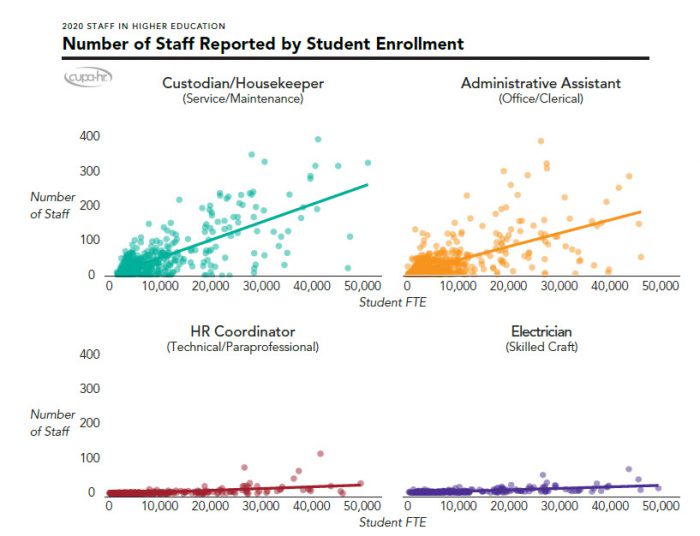PRESS RELEASE
FOR IMMEDIATE RELEASE
May 27, 2020
CUPA-HR Report Examines Relationship Between Student Enrollment and Staff Size
As higher education leaders plan for possible delays in campus openings, the staff who service the infrastructure of the campus and maintain its upkeep may be most at risk of being furloughed or losing their jobs. According to CUPA-HR’s 2020 Staff in Higher Education Annual Report, released today, it is critical to consider expected student enrollment when benchmarking for the number of staff needed for certain positions.
Most staff positions naturally increase in number with increases in student enrollment. However, the increase in number of staff is much steeper for some positions, such as custodians/housekeepers, than it is for others, such as electricians. For every 2,000-student increase in enrollment, for example, institutions report approximately 12 more custodians, but only one more electrician.

The report indicates that institutions have a higher number of custodians/housekeepers (median = 24) than any other staff position. The custodian/housekeeper position, one of the most vulnerable to enrollment changes, in included in the service/maintenance staff area, which has the highest concentration of Black/African American employees and the lowest salaries. Nearly one-fourth (22 percent) of service/maintenance staff are Black/African American, and they make $.89 on the dollar compared to White service/maintenance staff.
Other findings from the CUPA-HR 2020 Staff in Higher Education Annual Report include:
- Staff employees in higher education received a median percentage increase in pay of 2.4 percent last year, the largest increase since CUPA-HR began collecting data on non-exempt staff in 2013-14. Associate’s institutions provided the highest increase in overall staff pay, at 2.81 percent.
- The staff position with the highest growth is athletics equipment manager, with a 36 percent increase in number of positions in the past year. The position of recruitment coordinator had the greatest decline, with a 53 percent decrease in number of positions.
- Racial/ethnic minorities represent 31 percent of (largely non-exempt) higher ed staff. This is much higher than the percentage of minorities represented in administrator (16 percent), faculty (22 percent), and professional (23 percent) positions.
- The staff area with the lowest percentage of women and minorities is skilled craft, which is also the staff area with the highest salaries. The women who work in skilled craft positions make $.87 on the dollar compared to men.
- The area of skilled craft continues to be a concern in regard to succession planning, as a large percentage of skilled craft staff (43 percent) are over the age of 55 with fewer numbers of younger staff to replace them.
A total of 209,385 staff were reported for this year’s survey by 861 higher education institutions, covering 153 positions. This survey collects data at the incumbent level for all staff reported, allowing for the collection of salary, sex, race/ethnicity, age and years in position. Since this data was collected in the fall semester of 2019-20, this report provides the most up-to-date baseline workforce data for future analyses of how higher education will be impacted in the coming year.
To learn more about the Staff in Higher Education Survey, read the overview. Salaries, demographic comparisons and detailed trend information are available in the full report.
About CUPA-HR
CUPA-HR is the recognized authority on compensation surveys for higher education, with its salary surveys designed by higher ed HR professionals for higher ed HR professionals and other campus leaders. Learn more about CUPA-HR research.
CUPA-HR is higher ed HR. We serve higher education by providing the knowledge, resources, advocacy and connections to achieve organizational and workforce excellence. Headquartered in Knoxville, Tennessee, and serving over 31,000 HR professionals and other campus leaders at more than 2,000 member institutions and organizations around the country and abroad, the association offers learning and professional development programs, higher education salary and benefits data, extensive online resources and just-in-time regulatory and legislative information.
Contact Information
Erin Rosolina
Marketing Manager – Communications and Marketing
[email protected]


